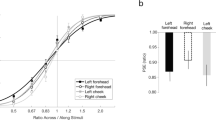Summary
The ability of humans to detect striated stimuli on the distal phalanges was found to be highly anisotropic. Observers were much more sensitive to stripes presented in the proximal-distal orientation than to stripes in any other orientation. This tactile anisotropy was contrasted with the well-known visual anisotropy in which sensitivity is greatest for stripes at the horizontal and vertical orientations. We suggest that both the tactile anisotropy and the visual anisotropy are caused by corresponding anisotropies in the distribution of preferred orientations of orientation-selective neurons with in the respective modalities.
Similar content being viewed by others
References
Appelle S (1972) Perception and discrimination as a function of stimulus orientation: the oblique effect in man and animals. Psychol Bul 78:266–278
Berkley MA, Kitterle F, Watkins DM (1975) Grating visibility as a function of orientation and retinal eccentricity. Vision Res 15:239–244
Campbell FW, Kulikowski JJ, Levinson J (1966) The effect of orientation on the visual resolution of gratings. J Physiol (Lond) 187:427–436
Costanzo RM, Gardner EP (1980) A quantitative analysis of responses of direction-sensitive neurons in somatosensory cortex of awake monkeys. J Neurophysiol 43:1319–1341
DeValois RL, Yund EW, Hepler N (1982) The orientation and direction selectivity of cells in macaque visual cortex. Vision Res 22:531–544
Essock EA (1980) The oblique effect of stimulus identification considered with respect to two classes of oblique effects. Perception 9:37–46
Essock EA (1982) Anisotropies of perceived contrast and detection speed. Vision Res 22:1185–1191
Essock EA (1990) The influence of stimulus length on the oblique effect of contrast sensitivity. Vision Res 30:1243–1246
Gardner EP, Costanzo RM (1980) Neuronal mechanisms underlying direction sensitivity of somatosensory cortical neurons in awake monkeys. J Neurophysiol 43:1342–1354
Green DM, Swets JA (1966) Signal detection and psychophysics. Wiley, New York
Kaas JH (1991) Plasticity of sensory and motor maps in adult mammals. Annu Rev Neurosci 14:137–167
Kennedy H, Martin K, Orban GA, Whitteridge D (1985) Receptive field properties of neurones in visual area 1 and visual area 2 in the baboon. Neuroscience 14:405–415
LaMotte RH and Srinivasan MA (1987) Tactile discrimination of shape: responses of slowly adapting mechanoreceptive afferents to a step stroked across the monkey fingerpad. J Neurosci 7:1655–1671
Leehey SC, Moskowitz A, Brill S, Held R (1975) Orientation anisotropy in infant vision. Science 190:900–902
MacMillan NA, Creelman CD (1991) Detection theory: a user's guide. Cambridge University Press, Cambridge
Maffei L, Campbell FW (1970) Neurophysiological localization of the vertical and horizontal visual coordinates in man. Science 167:386–387
Mansfield RJW (1974) Neural basis of orientation perception in primate vision. Science 186:1133–1135
Mansfield RJW, Ronner SF (1978) Orientation anisotropy in monkey visual cortex. Brain Res 149:229–234
Mitchell DE, Freeman RD, Westheimer G (1967) Effect of orientation on the modulation sensitivity for interference fringes on the retina. J Opt Soc Am 57:246–249
Orban G, Vandenbussche E, Vogels R (1984) Meridional variations and other properties suggesting that acuity and orientation discrimination rely on different neuronal mechanisms. Ophthalmic Physiol Opt 4:89–93
Phillips JR, Johnson KO (1981a) Tactile spatial resolution. II. Neural representation of bars, edges, and gratings in monkey primary afferents. J Neurophysiol 46:1192–1203
Phillips JR, Johnson KO (1981b) Tactile spatial resolution. III. A continuum mechanics model of skin predicting mechanoreceptor responses to bars, edges, and gratings. J Neurophysiol 46:1204–1225
Pubols M, LeRoy RF (1977) Orientation detectors in the primary somatosensory neocortex of the raccoon. Brain Res 129:61–74
Srinivasan MA (1989) Surface deflection of primate fingertip under line load. J Biomech 22:343–349
Stone J, Dreher B, Leventhal A (1979) Hierarchical and parallel mechanisms in the organization of visual cortex. Brain Res Rev 1:345–394
Taylor MM (1963) Visual discrimination and orientation. J Opt Soc Am [A] 53:763–765
Timney BN, Muir DW (1976) Orientation anisotropy: incidence and magnitude in Caucasian and Chinese subjects. Science 193:699–701
Vandenbussche E, Orban GA (1983) Meridional variations in the line orientation discrimination of the cat. Behav Brain Res 9:237–255
Warren W, Hamalainen HA, Gardner EP (1986) Objective classification of motionand direction-sensitive neurons in primary somatosensory cortex of awake monkeys. J Neurophysiol 56:598–621
Zemon V, Gutowski W, Horton T (1983) Orientational anisotropy in the human visual system: an evoked potential and psychophysical study. Int J Neurosci 19:259–286
Author information
Authors and Affiliations
Rights and permissions
About this article
Cite this article
Essock, E.A., Krebs, W.K. & Prather, J.R. An anisotropy of human tactile sensitivity and its relation to the visual oblique effect. Exp Brain Res 91, 520–524 (1992). https://doi.org/10.1007/BF00227848
Received:
Accepted:
Issue Date:
DOI: https://doi.org/10.1007/BF00227848




